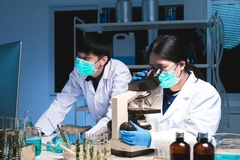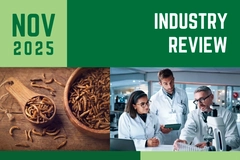Sweet Annie: Researchers unlock plant’s medicinal power against COVID-19 and cancer

14 Sep 2023 --- Arteannuin b, a compound found in the plant Artemisia annua, may help to inhibit the development of cancer cells and the activity of the virus SARS-CoV-2 which causes COVID-19. US-based researchers have identified the compound’s bioactive properties.
“We hope to promote basic science research (chemistry and biology) to apply it to medicine. A. annua is a common plant used to treat various illnesses, but not many studies focus on the molecular level of understanding of the compounds isolated from the plant,” co-author Francis Yoshimoto, assistant professor of chemistry at the University of Texas at San Antonio (UTSA), tells Nutrition Insight.

“A. annua has been sold as an herbal supplement, so people are taking the supplement for certain health benefits without complete knowledge of the health effects. Our study clarifies how A. annua potentially has anticancer and antiviral properties by blocking the activity of cysteine proteases – proteins that use cysteine in their active site.”
The plant, also known as Sweet Annie, has been used in Traditional Chinese medicine for over 2,000 years, note the researchers. It produces artemisinin, an endoperoxide-containing compound that is used in the treatment of malaria. Extracts of the plant’s leaves have also been used in treating various diseases, including cancer and COVID-19.
Therapeutic implications
By combining the research team’s expertise in chemistry, biochemistry and biology, the study’s authors hope to provide a detailed understanding of how the medicinal compounds in the plant work against human diseases.
 The crude mixture is purified from the extract via flash column chromatography. “Currently, many herbal supplements are sold to treat certain ailments without the proper understanding of how the compounds in the supplements work, and herbal or dietary supplements are therefore not approved by the US Food and Drug Administration,” highlights Yoshimoto.
The crude mixture is purified from the extract via flash column chromatography. “Currently, many herbal supplements are sold to treat certain ailments without the proper understanding of how the compounds in the supplements work, and herbal or dietary supplements are therefore not approved by the US Food and Drug Administration,” highlights Yoshimoto.
The researchers focused on COVID-19 as Yoshimoto had conducted some preliminary studies on the proteins of SARS-CoV-2.
“I designed the plasmid for SARS-CoV-2 main protease since this was an important antiviral drug target, and other researchers had started experiments on the topic and published their results. I decided that when my lab could work on this area, we would also perform experimental work to help us understand and combat the virus.”
When identifying therapeutic implications for the study’s outcome, he adds that the cysteine proteases – which the plant was found to block – are essential in cancer.
“Caspase-8 [a cysteine protease] was the focus of the brain cancer aspect for our study because glioblastoma overexpresses caspase-8,” he explains. “Other cysteine proteases overexpressed by cancer cells include cathepsins, which help tumor cells to invade immune cells.”
Moreover, he notes that abnormal cathepsin activity has also been related to other diseases, such as Alzheimer’s disease – where cysteine proteases have shown to play a role in the disease’s pathogenesis – bacterial infections, cystic fibrosis, arthritis, cardiovascular disease and obesity.
Study set up
Since the researchers had access to a considerable supply of A. annua material from a previous project, they decided to contribute to the plant’s antiviral and anticancer aspects.
“We used methanol as the solvent to extract the compound, and that’s where I got the idea that this must be how it works in biological systems,” explains Yoshimoto.
To test this theory, the researchers fractionated and characterized the plant’s leaf extracts through NMR spectroscopy and liquid chromatography-mass spectrometry, resulting in four fractions.
The team tested the toxicity of these fractions – cytotoxic activity – against glioblastoma (GBM) cells, a malignant form of brain tumor. The researchers purified the fractions to identify and test their components against cancer cells. Chromatography columns are performed iteratively, and fractions are collected in test tubes.
Chromatography columns are performed iteratively, and fractions are collected in test tubes.
The compound arteannuin B consistently showed cytotoxic activity against the cancer cells, note the researchers. They believe this results from inhibiting cysteine protease enzymes – protein degrading enzymes – overexpressed in cancer cells.
“We then derivatized arteannuin B by chemically reducing it, and Dr. Lin showed that the reduced form of arteannuin B was not active against GBM at the same concentration. This result informed us how arteannuin B has bioactive properties,” explains Yoshimoto.
To expand the results, Kaitlyn Varela, a doctoral student in Yoshimoto’s lab, showed that arteannuin B hinders the activity of SARS-CoV-2 main protease and caspase-8.
Expanding artemisinin research
Yoshimoto underscores that various reports have been published on how the different compounds from A. annua had biological activities against parasites and cancer. The current study’s compound – arteannuin B – was isolated and reported in 1973. “However, none of the studies looked into how arteannuin B has biological activity at the molecular level.”
“Past research efforts to elucidate the biological activity of A. annua compounds focused on artemisinin – the endoperoxide-containing compound from A. annua, which was the topic of the Nobel Prize in Medicine in 2015.”
He explains that artemisinin combination therapies currently treat malaria in Africa. The biological targets of artemisinin were found to target a wide range of proteins. For example, when searching for “artemisinin cancer” in Pubmed, the researchers found 1,248 articles. At the same time, very few reports have been written on arteannuin B’s link with cancer.
“Prior studies of arteannuin B and its biological activities showed potential anticancer properties, but they did not explain how arteannuin B has anticancer properties,” continues Yoshimoto. “Our study unambiguously determined how arteannuin B has biological activity by targeting cysteines – an amino acid with a thiol residue.”
 The compound may inhbit the growth of cancer cells and SARS-CoV-2’s viral activity.“Our 2023 study also explains how dihydroartemisinin reacts with cysteine thiol residues by oxidizing the free thiol to the disulfide via the endoperoxide.”
The compound may inhbit the growth of cancer cells and SARS-CoV-2’s viral activity.“Our 2023 study also explains how dihydroartemisinin reacts with cysteine thiol residues by oxidizing the free thiol to the disulfide via the endoperoxide.”
The research team hopes to submit a grant proposal to explore more biological properties of the medicinal compounds in A. annua and other medicinal plants.
Pharmaceuticals from plants
Yoshimoto highlights that understanding bioactive compounds’ mechanisms help to “give medicine to somebody in a smart way.”
“Understanding the mechanism of how medicines work is powerful because it enables medication to be given more effectively.”
Co-author Valerie Sponsel, at UTSA’s department of integrative biology, underscores the importance of nature in identifying new pharmaceuticals.
“Around 50% of prescription drugs are derived from natural products. They’re made by plants, fungi or bacteria. Half of these drugs originated in plants. That’s astonishing when you think of all the medicines in the world.”
“Different plants produce different medicinal compounds. As far as cancer is concerned, several types of compounds have always existed but have only been discovered in the last half-century. There will never be one compound that treats all cancers, so that is why research continues.”
The research team is in the first phases of studying the mechanism of action of A. annua’s medicinal compounds to decide how to deliver the best and target therapy, concludes co-author Chin-Hsing Annie Lin, an associate professor in the UTSA department of integrative biology and the department of neurosciences, developmental and regenerative biology.
“We can be more specific. We can lower the concentration to target tumors directly. We’re currently looking at encapsulating the compound into various concentrations, specifically targeting areas needing treatment.”
By Jolanda van Hal














